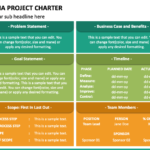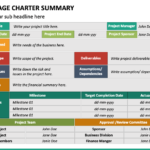Introduction
A project charter is a crucial document that outlines the fundamental aspects of a project, including its objectives, scope, stakeholders, and constraints. It serves as a roadmap template, providing direction and defining the project’s purpose.
A well-structured project charter document template not only ensures clarity and alignment among project team members but also acts as a reference point throughout the project’s lifecycle. This article will delve into the key components of a project charter document template and provide valuable insights on how to create one effectively.
You can download more templates from Download
Executive Summary
The executive summary sets the stage for the entire project charter document. It provides a high-level overview of the project, summarizing its purpose, objectives, key deliverables, and expected outcomes. This section serves as a concise reference for stakeholders, helping them quickly grasp the project’s essence and significance.
Project Description and Objectives
This section provides a detailed description of the project, its background, and the reasons for its initiation. It should clearly articulate the project’s goals and objectives, addressing the specific problems or opportunities it aims to tackle. Including measurable success criteria ensures that the project team has a clear target to strive for.
Project Scope
Defining the project scope is crucial to prevent scope creep and ensure that the project remains focused. This section outlines the boundaries of the project by specifying what is included and, equally important, what is not. It helps manage stakeholders’ expectations by clearly delineating the project’s limitations.
Related Article: Business Continuity Plan Template
Stakeholder Analysis
Identifying and analyzing project stakeholders are essential for effective communication, collaboration, and stakeholder register template. This section provides a comprehensive list of stakeholders, including their roles, responsibilities, and influence on the project. Understanding the stakeholders’ needs and expectations enables project managers to engage and involve them appropriately throughout the project’s lifecycle.
Project Deliverables
The project deliverables section outlines the tangible outcomes the project aims to produce. It provides a detailed list of specific deliverables, such as reports, software, prototypes, or other artifacts. Each deliverable should be clearly described and linked to the corresponding project objective. This section helps ensure that project team members have a shared understanding of the desired outcomes.
Project Timeline
Creating a project timeline is essential for effective project planning and scheduling. This section presents a visual representation of the project’s timeline, including major milestones, key activities, and dependencies. It helps the project team and stakeholders visualize the project’s progression and enable them to monitor and track progress effectively.
Check out HR Monthly Report Template in Excel as a related template.
Project Constraints and Assumptions
Identifying project constraints and assumptions is crucial for managing risks and uncertainties. This section outlines any limitations, such as budgetary restrictions, resource availability, or regulatory requirements that may impact the project’s execution. Clearly stating assumptions ensures that all project participants are aligned and aware of the underlying conditions that the project is based on.
Project Risks and Mitigation Strategies
Every project involves inherent risks, and addressing them proactively is vital for success. This section identifies potential risks, assesses their potential impact, and proposes mitigation strategies to minimize their likelihood or impact. A comprehensive risk management plan helps project managers anticipate and respond to challenges effectively.
Project Governance and Roles
Establishing a robust governance structure ensures accountability, clear decision-making processes, and effective project control. This section defines the roles and responsibilities of project team members, stakeholders, and any external parties involved. It clarifies the reporting lines, communication channels, and escalation mechanisms, facilitating smooth project charter.
Project Communication Plan
Effective communication is at the core of successful project management. This section outlines the communication channels, frequency, and formats for different stakeholders. It identifies the key messages, responsible parties, and expected outcomes for each communication activity. A well-defined communication plan fosters transparency, alignment, and collaboration among project team members.
You can download Project Cost Benefits Analysis Template from here.
Project Success Criteria and Evaluation
Determining project success criteria are essential for evaluating the project’s outcomes against the predefined objectives. This section defines the metrics or KPIs (Key Performance Indicators) that will be used to assess the project’s success. It also outlines the evaluation methodology and the frequency of evaluations. Regular evaluation allows project managers to make informed decisions and take corrective actions when necessary.
Related Template: Employee Performance Review Template
Conclusion
A project charter document template is a vital tool for successful project management. It provides a structured approach to project initiation, ensuring that all stakeholders have a shared understanding of the project’s purpose, objectives, and constraints.
By encompassing key components such as project description, scope, deliverables, stakeholders, timeline, risks, and communication plans, the project charter document template acts as a guiding document throughout the project’s lifecycle. By investing time and effort into creating a comprehensive project charter document, project managers can set the stage for successful project execution and delivery.
You can get complete set of Project Management Documentation from here.




